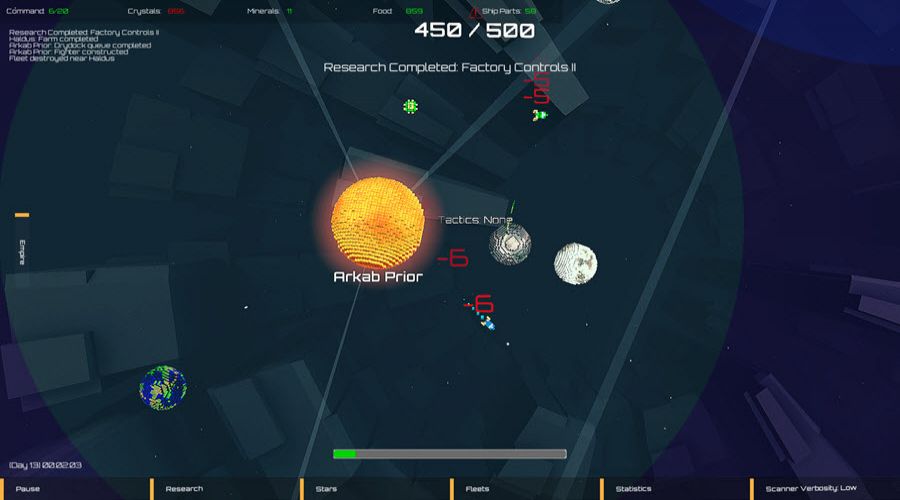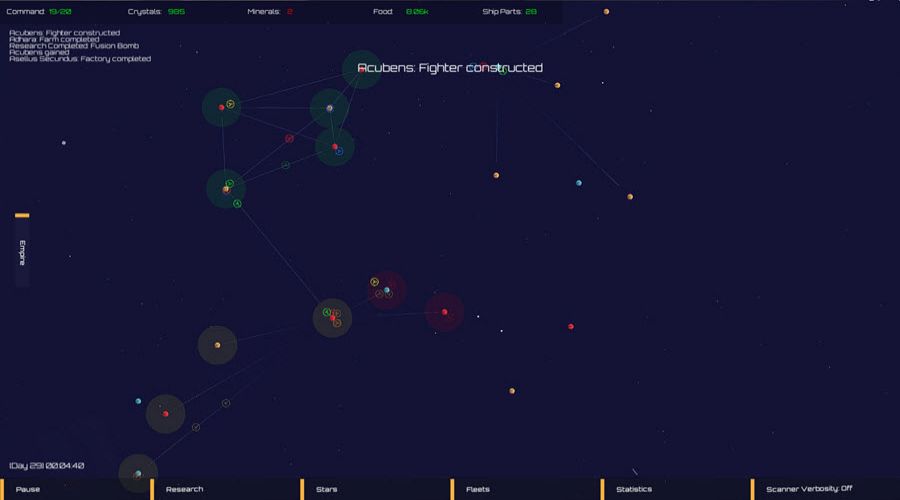Galactic Dominion

Review
Explore the galaxy, and manage, colonise and defend your star systems from those who wish to conquer you in this fast paced 4X strategy game for Forever Years.
There are two game types, Campaign and Quick Play. In campaign you’re able to choose from two game modes, real time or turn-based, depending on your personal preference. There are three acts, and each act has three chapters to play through, requiring you to complete certain objectives, so you can move to the next chapter.
These objectives start off fairly easy, but will become harder with each act you play through. You may have to colonise or invade star systems. To colonise a system you must first have a colony ship, which can be built at one of your current systems. Once you have one built you send it off to a system you’d like to colonise, assuming it’s not already taken. If it’s not already taken, you highlight the colony ship, which will allow you to then select Colonise, and it’ll colonise that system for you. You can only use a colony ship once, so you’ll have to build more if you want to spread across the galaxy; this is the same for any transport ships you build.

The second way to take control of a system is to invade it, for which you’ll need transport ships. You use them in much the same way you would the colony ships; highlight the transport ship and select Invade, and it will then invade that system. To help you on your way, you’ll be able to build other ships to aid you in your conquest, such as fighters, to protect your transports and colony ships or bombers, as well as space fortresses to protect your new colony from attack.
Once you have acquired a system, you’re able to take advantage of any resources which may be around by building refineries. Build farms so you’re able to feed your growing fleet, and factories to build ships. Not all ships will be at your disposal to build right away; there may be a limit as to how many ships you can build, and once that limit is reached you won’t be able to build any more. You can dismantle a ship, or if you lose a ship in battle then you’ll be able to build another one, so choosing the right ships for the job at hand is paramount; it’s no good having all fighters when you need to colonise somewhere.
You can also research new technology. There are four different branches of research for you to develop, consisting of Warfare, Computers, Construction and Planetology. In Warfare, you’ll find research for fleet command, ship weapons (such as laser, beam, missiles and bombs), and rifle upgrades for your troops, to aid them when invading a system. For Computers, there’s mining robotics, deep space scanners, factory controls, and modules for each of the ships. For Construction, you’ll find factory blueprints, armour, ship construction and different drives to power you around the galaxy faster. In Planetology, there’s food nutrients, troop training, cloning, mining prospect, collective farming and autonomous farming.
There are several levels to most of the research available; unlocking one research will allow you to unlock the next level of research. So, unlocking Food Nutrients 1 will allow you to unlock Food Nutrients 2. Some you won’t be able to unlock until you’ve reached a certain point within the game. You’re be able to see which ones are available to you on the research tree. It will also show you any current research progress here in the top left corner of the screen.
In between each star system you’ll find star lanes; these connect to other systems and are the fastest way to travel between systems. Some star lanes won’t be visible to you until you visit that system, and then it will reveal which way the star lanes go. You can travel to systems without using the star lanes, but it is slow in comparison.
Instead of playing the Campaign, you have the option of Quick Play, where you can setup the galaxy to your personal preference. You can name the galaxy, and choose the size of the galaxy you want to play in (ranging from small to huge), as well as the number of stars in the galaxy (five to sixty). You have a choice of four different races to play as, and if you can’t make up your mind, you can select random and take the luck of the draw. The four races in the galaxy consist of Humans, Machines, Etherials and Monsters.
Each of the races has different bonuses and penalties. Humans don’t have any bonuses or penalties, whereas monsters have bonuses for workers, as well as troop growth and troop attack, but they have penalties for food consumption. So, playing as monsters will allow faster growth of your workers and troops, but they’ll consume more food, which means you need more farms to feed them, otherwise they’ll die from starvation.
You can either choose the number of opponents (AI) you wish to face (one, two or three), along with which race, or you can have them randomly chosen. You are also able to set the aggression (low, normal, high or random) of each opponent you face. There is a difficulty modifier ranging from simple to impossible, and each of these difficulties will come with their own pluses and minuses. Playing a simple game will give you some extra boosts, but it’ll impact on your final score (x0.25), while playing impossible will give the AI all the bonuses, but double your final score. Playing any difficulty below normal will also disable the achievements.
A few other options are also available, so you can customise your game. The choice of options are User Interface & Controls (Big Fonts, Mouse Camera Pan and Zoom to Centre), Audio (Mute all, Sound Effects, Music and Ambient Volume Control), and Game (Auto-Save, Style Palette and Style Pattern). You can also Reset Campaign and Options here, and Control Mapper.
There is a tutorial which covers everything in the game, but you can only watch what to do; I’d have liked a more hands-on tutorial to learn how the game plays, as I found it a bit hard to see what I needed to do (appointment booked at Specsavers). So, I was a little confused at the start, but a bit of trial and error clicking here, there and everywhere and I got the gist of how to play.
I found the research tree a bit cumbersome and the area where it shows your current technologies being researched in the way. So I’d have to zoom in and out while dragging this way or that to fully see the research tree. Once a technology has been researched, you’ll have a big popup hit your screen, which isn’t too bad. However, when you have lots of research being completed at once, you get popup after popup after popup each time as you close one, all while you’re trying to do something else, like protecting your systems. I think having a smaller, non-intrusive message saying that said research is done would be better.
Review written by Piston Smashed™ for Zeepond.com!
Positives
+ Not overly complicated+ Real-time or turn-based options
+ Four different races to play as, each with different bonuses or penalties
+ Achievements
Negatives
- Research finished notices are a bit annoying at times- Research tree is a bit cumbersome
- No cards
Review Summary
Research technology, build fleets of space ships, and travel the star lanes to new star systems as you invade and colonise the galaxy.
Share this review!
Zeepond Rating: 7/10










Video
Game Categories
All Game Reviews (1351)Hardware Reviews (0)
Action (341)
Adventure (151)
Alpha Games (2)
Anime (5)
Board Games (3)
Casual (135)
First Person (19)
First Person Shooter (30)
Hardware (0)
Horror (38)
Massive Multiplayer Online (4)
Pixel Graphics (22)
Platformer (93)
Puzzles (64)
Racing (26)
Role Playing Game (61)
Simulation (53)
Sports (20)
Strategy (246)
Third Person (11)
Utility software (1)
Virtual Reality (22)

